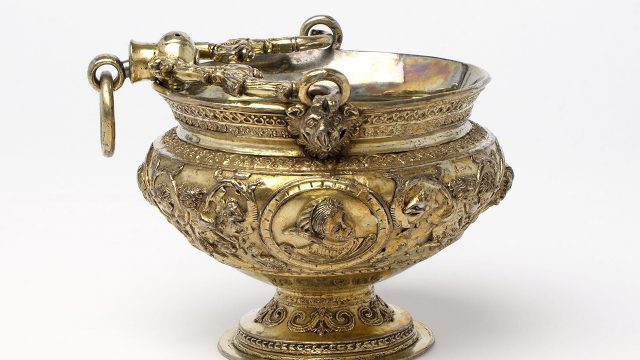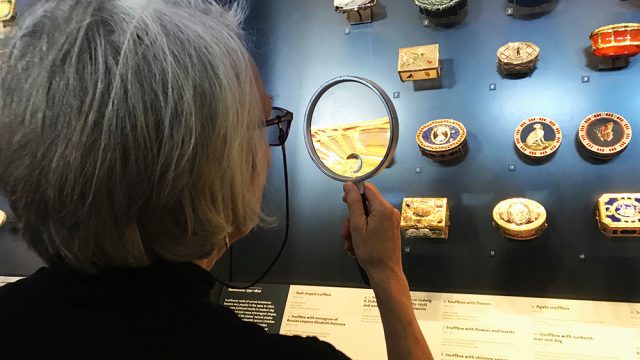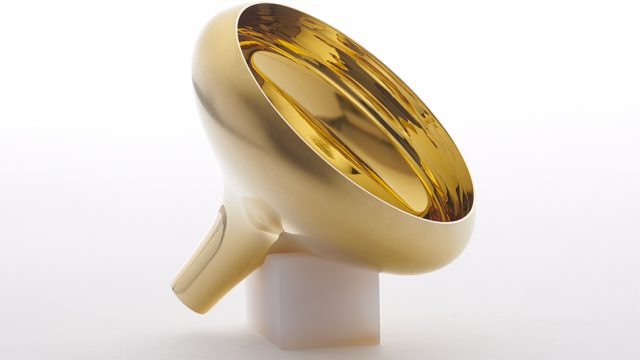The article below was written by Alexander Morrison who volunteered with us for two months last year and helped us greatly with our travelling exhibitions programme. Alex graduated from Manchester University with a BA in History Of Art, and is about to start an MA in Russian History of Art at the Courtauld Institute. Although his main area of interest is modern and contemporary art, he has chosen here to research a piece of historic silver from the Gilbert Collection which is currently part of the temporary display ‘Personal Favourites’ in the Silver Gallery.
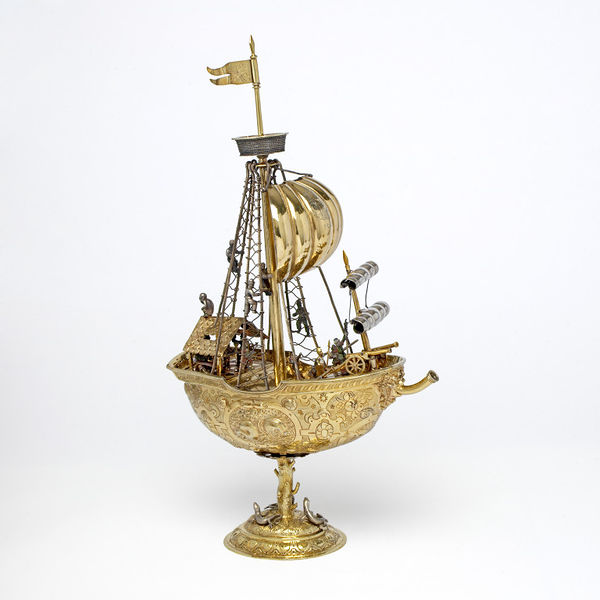
I volunteered with the Gilbert Collection for two months, during which time I have been introduced to many unique objects that, coming from a predominantly contemporary area of study, I would never have engaged with previously. The collection holds many exquisite examples of highly skilled craftsmanship with a constant theme of blurring of the lines between aesthetics and functionality. One such example is the ewer in the shape of a nef (ship) from Regensburg, Germany c.1610. The dazzling golden vessel is bustling with life as its crew clamber the rigging whilst officers or noblemen dine inside the rear cabin. On the roof of this cabin sits a monkey, an element of exoticism that adds to the allure of this piece, and one that may allude to vanities deriving from Sebastian Brant’s satire Daß Narrenschyff (Ship of Fools) from 1494. There is the wonderful addition of two lizards at the base of the handle, their heads raised towards the bottom of the nef.
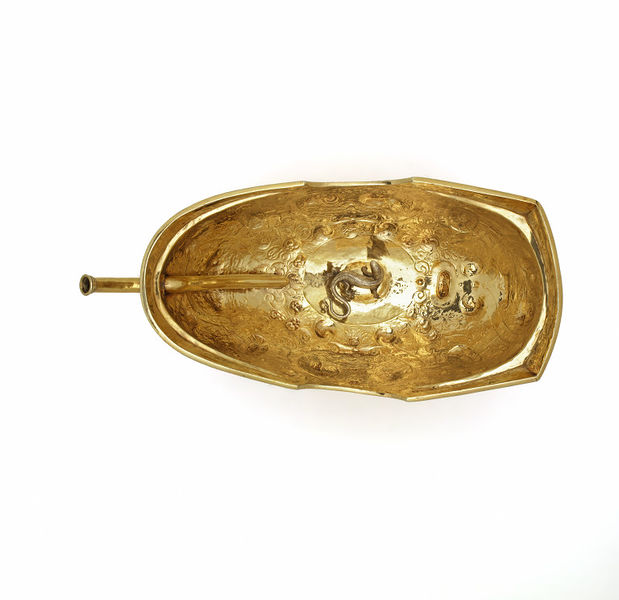
Nefs offered craftsmen infinite opportunities to exhibit their skills. As well as being pieces of ostentatious tableware, they were containers for anything ranging from table salt to bathroom towels. In this version, the spout or siphon that projects from the figurehead suggests that it could be used as a ewer for drinking. However I believe its design is far more ornamental than functional, and this point of view is further reinforced when, upon opening it up, we are greeted by a decorative lizard applied to the interior of the hull.
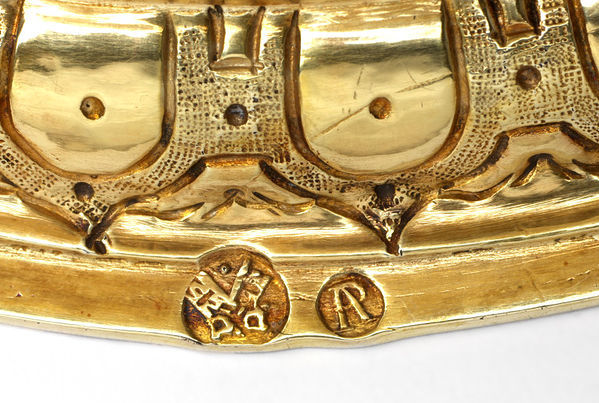
After researching other nefs within the V&A collection I discover that the creatures on display on the Gilbert ewer are exemplary of the interest in casting naturalistic imagery of animals onto such objects, a practice developed by the Nuremburg makers of the sixteenth century. Yet interestingly, the maker’s mark on this nef is not from Nuremburg but from the neighbouring city of Regensburg, which could reflect the latter’s status as a Free Imperial City, where many wealthy patrons would have been interested in buying such beautiful objects.
This discovery highlights to me the importance of understanding the Gilbert nef’s historical context. Therefore I decided to delve deeper into the period in which it was created, and as a result discovered the complex social order that surrounds the object.
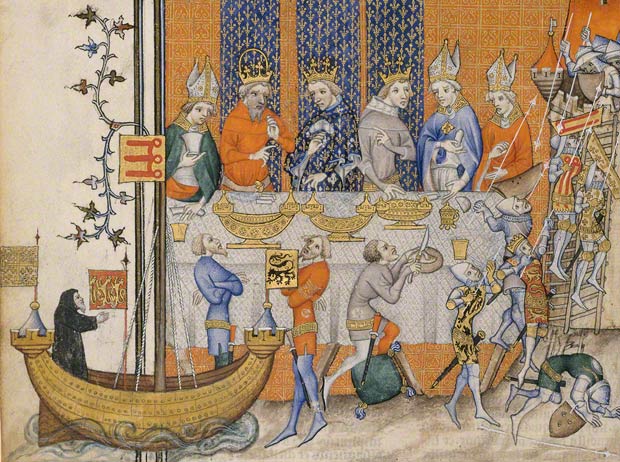
Nefs found their peak of use in France under the rule of Louis XIV, in the late 17th century. They were the centre of ceremonial traditions, with stories including priests bowing in the presence of Louis XIV’s golden vessel. At this time, it was commonplace for the king to insist on distinct separation between him and all of those whom he ruled, and this idea of “the divine right of kings” was epitomised by the nef. At banquets, only the monarch, or whoever held the position of most power at the table, would be allowed to use it. The nef was therefore the most extravagant and the most exclusive object on the table, and it came to represent the meticulously stratified society in which it was created.
As well as standing as a symbol of division and hierarchy, David C. Sutton interestingly notes in his essay ‘Nefs: Ships of the Table and the Origins of Ettiquette’ that the vessel’s heyday coincided with the introduction of a strict etiquette that came to dominate the seventeenth-century dining table. Table manners and presentation were held in the highest regard, and food was accepted at the table more closely based upon its ability to fit in with the overall aesthetic “tableau” of the banquet rather than upon its taste. With this information in mind the nef and all of its details, ranging from its golden exterior to the incredibly intricate depictions of the animal kingdom, becomes inextricably bound to the vanity that defined fine banqueting. Subsequently, the layers of class and tradition that make up this beautifully crafted piece of tableware begin to unravel.
The Gilbert nef is much more than a highly crafted object that serves a secondary function: it is an elaborate piece of history that is drenched in tradition, the centerpiece of a whole era of strict etiquette hierarchy. It is the perfect example of the way in which the Gilbert Collection has offered me a fresh perspective on artistic practice that I hope to carry through with me for many years to come. I would strongly advise anyone to come and see this object and the rest of the collection for themselves; there is a good chance that you too will uncover some of the intricately layered histories than lie embedded within each wonderful object.
Alexander Morrison
